Asian Painting from Mongolia
Cultures of all countries on one painting - the painting "One Day of the World"
The painting has created artist Sergelen N together with Ganzam S, Sainzul Sh and Hosbayar N. The painting is 21 meters long, 2.5 meters wide and has a total area of 52.5 square meters. Mr. Nadmid spent about 10 years in painting research and completed this painting together with his students also over a period of more than 10 years. The painting shows the countries of the world by continents, including 193 countries, and emphasizes their lifestyle, animals, plants and natural formations, national customs, culture, values and constructions for which each country is known. The painting contains more than 5000 individual images created with precise techniques of Mongolian painting, embodying the unique style of "Mongolian painting".
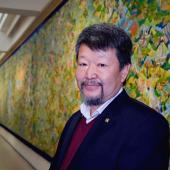

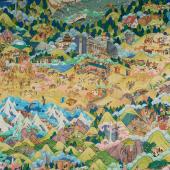
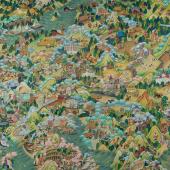
Hello Mr. Nadmid,
We are very pleased that you accepted our invitation and took part in the interview. Your picture is great. I never thought that I could see the whole world in just one picture and recognize the culture of other countries on this.
artist ritual: When and how did you first have the idea to tackle this artwork, and what scene did you envision at the beginning?
Mr. Nadmid: I worked as a teacher at the Higher School of Art since 1990. When the Higher School of Art became the University of Fine Arts, I subsequently taught for eight years, graduated from two degree programs, and met many wonderful students. It was then (1998) that the idea of painting this picture first arose. While I was teaching, I became interested in drawing other nations in the Mongolian style. At the beginning I was inspired by the picture "A Day in Mongolia" by the famous artist Marzan Sharav. At that time, many tourists from abroad came to Mongolia to see the painting "A Day in Mongolia". That gave me a big push to start the painting. Basically, every artist has the goal and dream to paint a big picture. My big dream was this "One Day in the World" painting. Initially, I had a very big picture in mind because I wanted to include all the countries in the world. I worked out the basic design of the painting and planned the original painting to be 21 meters long. It required a lot of research for me, and sometimes I would jot down the new ideas while thinking about the painting.
artist ritual: Please explain the main drawing materials and the style and trends of this drawing?
Mr. Nadmid: After graduating from an art college with a specialization in Mongolian painting, I continued my studies at the V. I. Surikov Institute of Painting in Moscow. Having studied and taught Mongolian painting, my goal was to one day create works in the traditional Mongolian painting style. I starched the material with white cloth and painted in the traditional way with gouache and earth color. Since the introduction of the term "Mongolian painting" in the fine arts, our generation of artists has studied and developed the traditional methods of our nation's fine arts and created dozens of works of art to pass on to the next generation. Thus, many works have been created in the Mongolian style of painting.
artist ritual: What do you want to convey with this painting?
Mr. Nadmid: Since my childhood I was interested in the culture of the countries of the world, I wanted to see them with my own eyes, and I read many books and magazines. I think my curiosity helped me to develop this image. Therefore, I wanted to include in this painting central aspects from national cultures, their developments, national dresses, their nature, animals there, the corresponding climate, etc. of many nations. The world system itself is a wonderful thing, and beside it there are many admirable works of mankind. I wanted to show all these with my own thoughts and feelings. My main goal was to help people learn about the culture of other countries with the help of Mongolian Мalereistil, and to make the style of Mongolian painting more popular internationally.
artist ritual: I think it took a lot of courage and patience to start this difficult subject. Twelve years is a long time, had you ever thought of giving up?
Mr. Nadmid: During this time I had never thought of giving up. On the contrary, it was very interesting. While researching my drawings, I collected a lot of interesting materials that motivated me to keep painting. After completing a brick that I had planned for a long time before, I wanted to finish this process quickly and see the finished picture. (Laughter) Time passed so quickly that I didn't realize this until I had finished the work. A person achieves success by overcoming certain obstacles to reach the goals they set. I think the beginning is 50% of the goal. This means that a person who gets discouraged will never see positive results. That is very unfortunate.
artist ritual: What were some of the problems you faced from the beginning of the painting to the end?
Mr. Nadmid: That's a good question. When I first came up with the idea, the first thought was, of course, the size of this painting. I knew and expected that I would be painting this picture for many years, so I needed the funding. Of course, there were minor problems. For example:
- Where can I paint my picture?
- Where will the funding come from?
- Who can I paint with?
- etc.
The first problem was that there was no wide cloth for drawing in Mongolia at that time. And so on, there were definitely problems. One of my advantages was that I had over 20 students, so it was not very difficult to find an artist to work with. Over the years, in order to paint this picture, in addition to the materials, I needed a large studio to paint the picture. The most important thing was funding. Basically, I spent a lot of time trying to find someone who could finance me. It was not easy to find people who understand, support and finance art in the long term. An artist shouldn't throw away his family and his working life just to work on a painting. And finally, a good friend I had met in Moscow was very interested in my project. He decided to finance it. That's how this painting began.
artist ritual: Can you briefly introduce the students you painted with?
Mr. Nadmid: After meeting and talking with many of my students, three students began to paint the picture with me. Khosbayar N, Ganzam S and Sainzul Sh agreed to work with me on this painting. My students were very talented and good artists. You can say that they completed their student work on the painting process.
- Ganzam has been teaching at the University of Fine Arts for over 20 years.
- Sainzul is a great independent artist.
- Hosbayar is also an independent artist and currently works as the head of the entertainment department of the Genghis Khan Museum.
artist ritual: What country were you most interested in while working on this painting?
Mr. Nadmid: When I was researching information, the Internet was not developed at the beginning, so I went to bookstores and libraries to collect information. At that time, I was interested in countries with different natural systems and historical buildings. I was also very interested in Indians, African as well as Australian tribes. I wanted to experience their customs, attitudes, skills, etc. in harmony with nature and native wildlife.
artist ritual: I have heard that an artist's work is no different from that of his own child. How many valuable works do you have that you don't want to sell?
Mr. Nadmid: Of course, all artists love their artwork because they put their heart into it. But I rarely have drawings that I keep. Of course, my finished works are exhibited. For me, it is right to create a piece of art and not keep it for yourself, but to show it to others, to communicate the idea behind it, that is, what you want to convey to the image with others. If someone likes it, they will buy it, of course. One should not be afraid of not wanting to paint it again, even though one had painted it before. During my studies in Russia, I was very interested in Western art. That's why I paint monumental paintings as well as Mongolian paintings. Modern abstract painting is also very interesting, others think it's very easy, but as an artist you need a lot of feeling to paint it really well.
artist ritual: If there are children and young people from other countries who want to become artists, especially those who are interested in traditional Asian painting and Mongolian painting, do you have any advice for them?
Mr. Nadmid: Of course, I do. I can relate to them well because I have been a teacher myself for many years. In the 1990s, when I was teaching, a student from Brazil came to Mongolia to study Mongolian art. In recent years, many foreign students have come to study at the Mongolian University of Fine Arts - from Korea, China, Russia, etc. Mongolian painting is not only for Mongolians, it is open to everyone. If children and young people from other countries are interested in Mongolian painting, they can come to Mongolia to study art. If you really want to study Asian painting and Mongolian painting, you should first do research and acquire some knowledge. It is also possible to learn the basic knowledge on your own. For example: basic elements like fire, water, clouds, flowers and practicing fine brush strokes. I believe that in the future the time will come when Asian Art will take an important place in the world, and the scholars from Asian countries will spread this art form all over the world. Then young people in Western countries who are interested in Asian art can learn Asian art in their own countries.
artist ritual: Some critics perceive artists as people from another world, with a different attitude toward life, thinking and feeling compared to average people. What type of person is an artist for you?
Mr. Nadmid: I get this question very often. I have been interested in art since I was a child, and most children are interested in art, too. Back then, I looked at pictures in books and magazines and thought, who painted this picture? What type of person is this artist? At that time I imagined an artist with a hat and scarf. Now I am an artist myself, I know many other artists and I make friends with them. It's less important what the artists look like. What is more important is a person's inner world, his ability to think and his imagination. Of course, talent is not for everyone, only those who can develop this talent and discover themselves can become artists. Artists such as painters, sculptors, etc. have the characteristic of creating everything themselves compared to other art professions. Artists of other art forms bring their works to life, and are partially dependent on others. Artists such as singers, dancers, actors, etc. produce their works of art with the involvement of other participants. I think painters are more independent than other art professions because they do everything themselves, from the initial idea of their work to the preparation of materials and drawings.
artist ritual: I read in another historical article: Genghis Khan's main goal and reason for conquering and unifying the country was his desire to create peace by uniting the people of this world to live in harmony. I think the fact that you include the whole world in one picture is also a sign that you want peace in this world.
Thank you for your wonderful answers to our questions. Good luck with your future artwork.
Mr. Nadmid: Good luck to your magazine team and thank you very much. Also, I hope the readers enjoy my interview.
More impressions from the painting "One Day of the World"

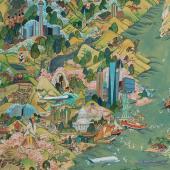
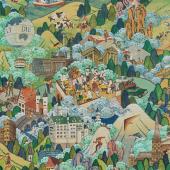


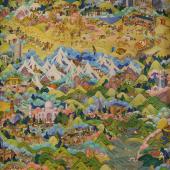


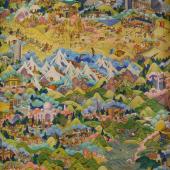
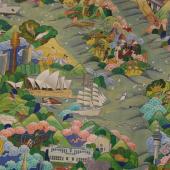
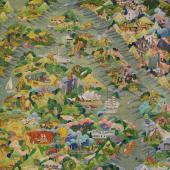

Curriculum vitae Sergelen Nadmid
E-Mail: tsnsergelen64@gmail.com, tsnsergelen@gmail.com
- Date of birth: 1964 (Ulaanbaatar, Mongolia)
- Profession: Artist
Education:
- 1979-1983: College of Fine Arts, Ulaanbaatar.
- 1983-1990:
- V. Surikov State Art Institute Moscow, Russia
- Bachelor of Arts, Monumental Art
- 1990:
- Mongolia State University of Art and Culture,
- Master's degree
Professional experience:
- 1990-1995: Teacher, College of Fine Arts.
- 1995-1996: Dean, College of Fine Arts
- 1996-1998: Director, Institute of Fine Arts
- 1998 to present:Freelance artist of Mongolian Artists Association:
- 2006-2008: director, Chinggis Gallery, Ulaanbaatar
- 2014-2015:
- Dean, National Faculty of Art, School of Fine Arts,
- State University of Art and Culture of Mongolia
- 2015-2020:
- Dean, Faculty of Fine Arts
- Mongolia State University of Art and Culture
- 2020-present:
- Dean, National Faculty of Arts
- Mongolian State University of Arts and Culture
Central activities:
- 1990 until today: participation in numerous art exhibitions
- 1996: 67 portraits of Mongolian Khans and heads of state
- 2002: Completed the interior design of the Turquoise Great Hall of the Ministry of Foreign Affairs of Mongolia, Ulaanbaatar, mural 6m x 12m named Three Stages of Mongolian Revolution
- 1991-2014: author of various logos and emblems of the state and NGOs, as well as medals and pins
- 2008-2019: Mongolian painting "One day of the world", 2,5 m x 21 m
Awards:
- 1995: Leading Artist, Mongolian Artists Association.
- 2001 and 2011: State Medals of the Mongolian National Revolution
- 2004: Medal of Honor, 80th Anniversary of People's Education, Ministry of Education of Mongolia
- 2014: Mongolian Chief Cultural Commissioner and Artist
- 2019: Honorary professor, Mongolian State University of Art and Culture
- 2019: Award named after the Mongolian Arts and Crafts Association
- 2020: Grand Prize Silver Belt of the "Oron zai" Society
- 2021: Order of the Red Banner for services to the work of Mongolia
List of the most important artworks by Nadmid Sergelen:
- 1993: "Serial still life", 5 pieces, 30x40cm, gouache on cotton.
- 1984: "Mongolian still life", 100x60cm, oil on canvas
- 1990: "Mongolian Lunar New Year", Mongolian painting, 40x60cm, gouache on cotton
- 1992: "Earth and space" OPPArt, 100x100cm, mixed media
- 1992: "Earth and space", sculpture, 40x40x40cm, wood and iron
- 1993: "Beginning of earth and space" diptix art, 70x100cm, oil on canvas
- 1993: "Dinosaurs of the sky", 120x130cm, oil on canvas
- 1994: "Flowers" triptix art, 40x50cm, oil on canvas
- 1995: "Life community" (Ami zangilaa), triptix art, 45x50cm, oil on canvas
- 1996: Mongolian khans and heads of state portraits, 67 pieces, 20x30cm, gouache on cotton
- 1997: "A day of Mongolian winter" Mongolian painting, 150x130cm, gouache on cotton
- 1998: "A day of Mongolian summer" Mongolian painting, 150x130cm, gouache on cotton
- 2002: "History of the three stages of the Mongolian state", Rosipisi, tempera, hall of the Ministry of Foreign Affairs of Mongolia
- 2008-2019: "A day of the world" 21m x 2.5m, gouache on cotton
- 2013: "Great Chinggis Khan" 80x100sm, oil on canvas
- 2014: "Falcon" triptix art, 33x45cm, oil on canvas
- 2014: "The whole history of the world", 21m x 2.5m, gouache on cotton
- 2015: "Golden autumn" 80x60cm, oil on canvas



